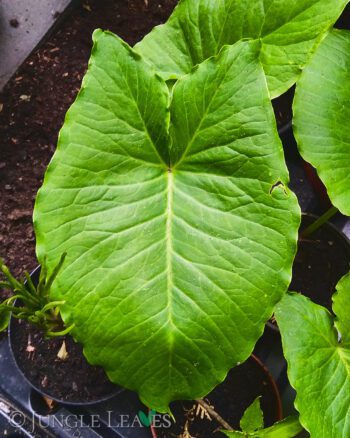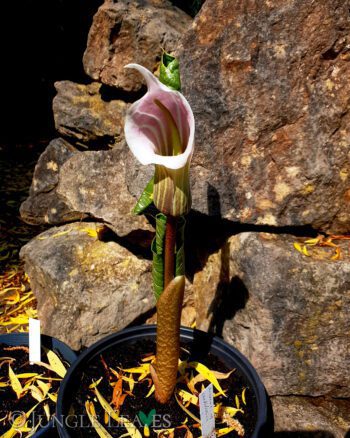Philodendron ‘Red Sun’
9,99€ incl. VAT
Easy to care for. New leaves with very noticeable red color, later dark green. A real eye-catcher.
- Description
- Care
- Additional information
Description
Description
Philodendron hybrid with compact growth (no vine). New leaves are bright red color and then turn dark green with time. This cultivar grows rather slowly and produces only a few, but eventually quite large leaves up to 40cm in length.
Very good houseplant for bright locations but without direct sunlight.
You will receive a young plant in a 9cm square pot.
Care
50 cm
60 cm
Partial shade
18 – 28 °C
50 – 90 %
This plant grows in the understory of rainforests.
Real tropical rainforest has pretty little to do with what most people imagine when they hear “jungle.” One thinks of impenetrable undergrowth, constant moisture, and that there is everything in abundance for plants. Unfortunately, these misconceptions often lead to many of these rainforest inhabitants being cared for incorrectly. In reality, the undergrowth is mostly is not particularly dense, the soil is very poor in nutrients and loamy and sometimes it is quite dry for a long time!
To avoid such mistakes, here are our detailed care instructions for this plant:
- Location/Light: This plant likes a lot of light, but not full midday sun. It likes a location with bright but indirect light best, for example, placed directly by a west/east window or placed slightly off to the side near a south window. A little direct morning sun, or in winter a little more direct sunlight is not harmful. However, you should be careful that this does not damage the leaves. Especially after prolonged cloudy periods, direct sunlight can “burn” the leaves.
- Temperature/Humidity: This plant comes from a tropical climate and naturally grows best in tropical temperatures and humidity. However, it is also very tolerant of “regular” conditions in an apartment.
It should not be below 18° C at night and at least 20° C during the day. It should not be exposed to temperatures over 28° C for prolonged periods of time.
The relative humidity of the air should be 50% or more. Especially in winter it should be protected from dry heater air to avoid unsightly dry leaf edges.
- Water/Fertilizer: This plant likes it less wet than one would assume for a rainforest species. The substrate should never dry out completely, but it should definitely not be really wet for a long time, this can damage the roots! So better to water a little less, and in between let at least the surface dry. How long this takes varies depending on the location, pot size and also season! Therefore, watering should never be strictly on schedule, but when it is necessary. Watering both from above and from below (through a saucer or similar) is possible and equally effective. Watering can be with moderately hard tap water, rainwater or distilled water.
Fertilizing should be done during the main growing season, from about May to September. If you do not provide additional lighting, this plant will not grow much, if at all, from October to April, and does not need to be fertilized. No special fertilizer needs to be used. A regular complete fertilizer (N-P-K + trace elements) for indoor plants is sufficient. Liquid fertilizers, fertilizer sticks or similar are all suitable and can be used according to the manufacturer’s instructions.
- Substrate/Pot: Pot this plant in a loose, acidic (pH below 7) and air-permeable mix. You can use regular soil for houseplants, but it should be amended with, for example, perlite to loosen it up. This mix does not correspond at all to the natural environment of this plant. The soil in the rainforest has only a very thin layer of nutrient-rich humus, with mainly clay underneath. However, plants in nature do not necessarily grow the way they “want” to. This species responds very well to giving it a substrate that is much “nicer” to it than what it would have in nature!
The pot for this plant does not need to be very big, but should be chosen so that it does not dry out too quickly. However, the pot should also not be too big, otherwise it will not be evenly moist. This leads to the substrate already being dry at the top, but still wet at the bottom. Then you think you have to water again and drown the plant, which in reality is still moist enough. Some experimentation is required for the right pot size. As a guide, if you can water about every 5 to 10 days, and the substrate is almost completely dry in between, the size is well chosen.
Additional information
Additional information
| Weight | 0,2 kg |
|---|---|
| Dimensions | 9 × 9 × 20 cm |
| Will be shipped as | potted plant |
| pot size | 9cm square pot |











